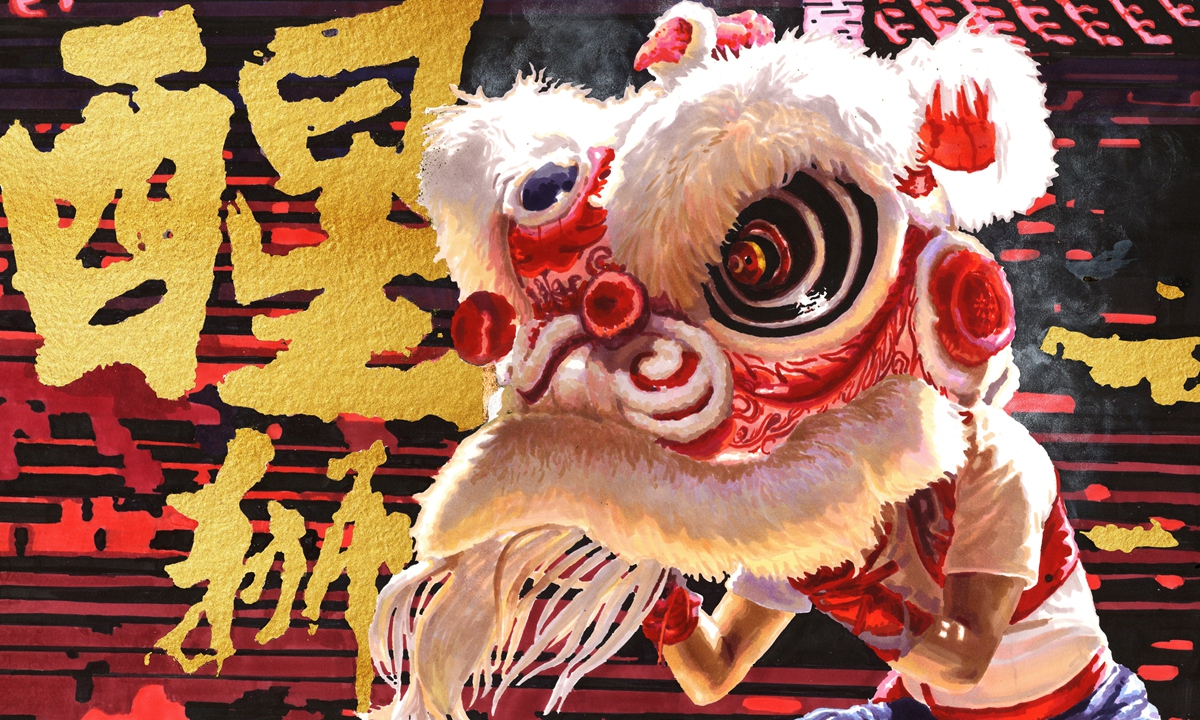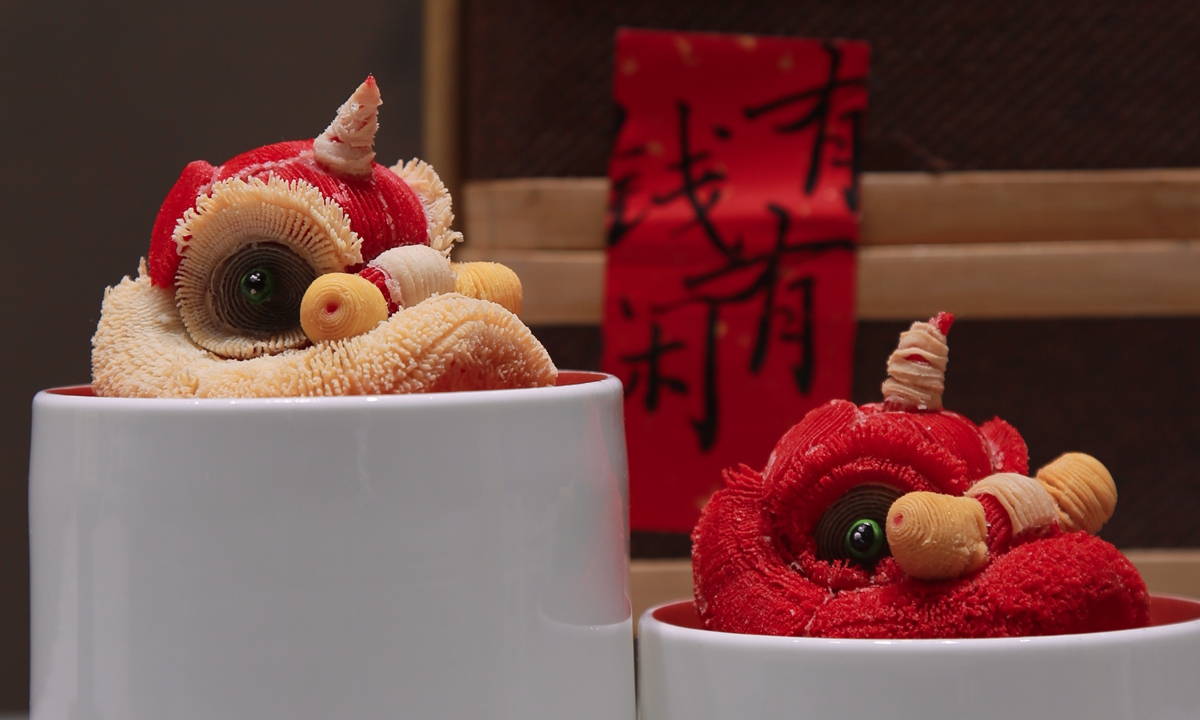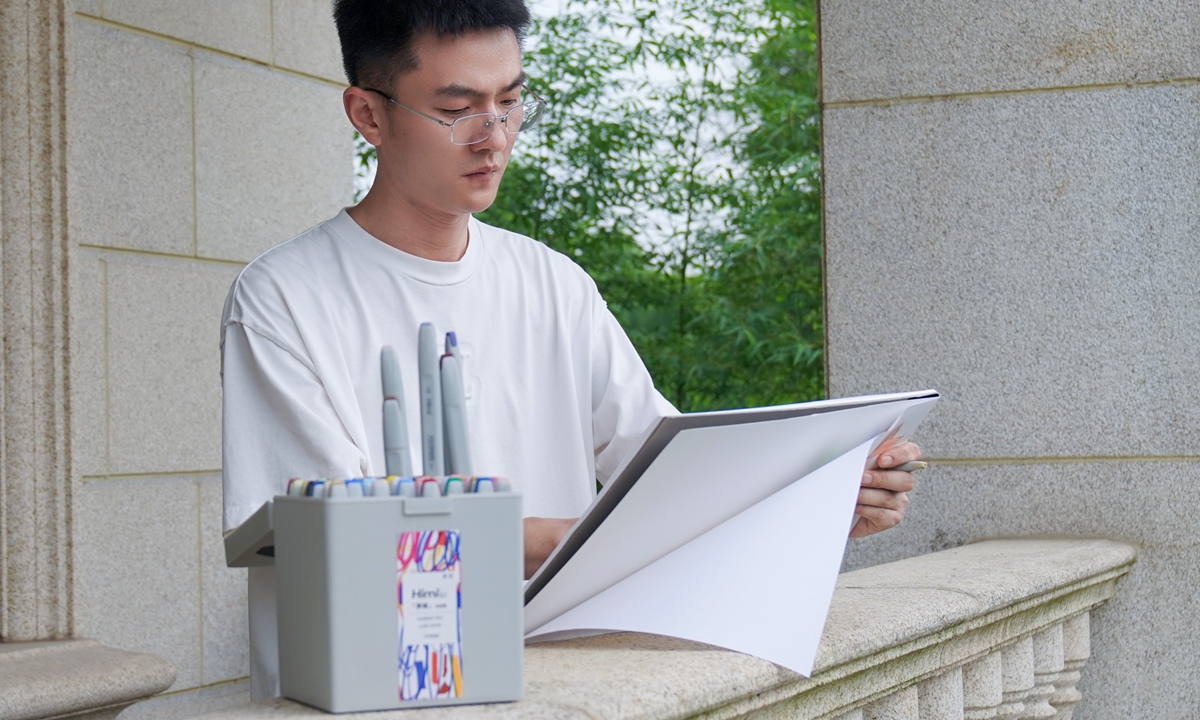
Artist Li Shichuan's xingshi painting Photo: Courtesy of Li Shichuan
Editor's Note: How can art and culture from the past survive in a globalized world? Inheriting the treasure of art and culture from the past thousands of years, young Chinese have created a new trend -
Guochao, or China chic. It refers to a movement started off by an increasing number of young people who are endeavoring to revive and reinvent on China's traditional culture.
We can see fashion designers drawing inspiration from the precious murals inside the Yungang Grottoes, and traditional instrument players creating all new trendy music on the pipa. These young
Guochao trendsetters have helped China's cultural legacies be passed down and preserved for future generations.
In this new column, the Global Times will interview young people who are using wisdom and creativity to reinterpret traditional Chinese culture in their particular field of expertise. The first installment focuses on the reinvention of the mesmerizing image of the lion dance.
The Chinese lion dance is a traditional dance that showcases the cultural identity and spiritual beliefs of the Chinese people. It is performed on festive occasions, such as Chinese New Year, to attract good luck, prosperity and happiness.
The lion dance originated in the Tang Dynasty (618-907), a time when the lion was regarded as a powerful and auspicious animal that symbolized courage, stability and wisdom.
Two main styles of lion dance can be found across the country: the southern lion dance and the northern lion dance. Nowadays, one southern form is especially well preserved in South China's Guangdong Province, where its local name is xingshi, or Awakened Lion.
Besides the exciting dance moves, the beautiful mask and costume used in the dance - the "lion" - have also become a source of inspiration for young people to recreate on.

Wu Yang's xingshi pastries Photo: Courtesy of Wu Yang
Bring to lifeLi Shichuan, a 31-year-old artist from North China's Hebei Province, has gained recognition for his splendid paintings of xingshi created with marker pens. Little did he know that this art form would garner so much attention on Chinese social media and inspire more young creators to join the
Guochao movement.
Li initially focused on landscape and architectural works when he first started painting but gradually began exploring the myriad possibilities of marker pen art.
In the beginning of 2020, Li began sharing his artworks on social media platforms and started gaining popularity. Later, one artwork was exhibited at an art festival for cross-Straits cultural exchanges. At that moment, he realized that his creations should convey something meaningful.

Marker pen artist Li Shichuan Photo:Courtesy of Li Shichuan
Having a fondness for traditional Chinese culture, he decided to use it as the theme for his artworks. His first traditional cultural-themed piece Awakened Lion garnered millions of views upon release, providing him with the motivation and confidence to continue creating. Over time, Li's collection of lion-themed artworks grew, attracting more attention and exhibition opportunities, which has earned him the label as a young
Guochao artist.
Using strikingly vibrant colors like blue, red and white, Li makes the tradition lion with its pair of round eyes looking powerful and lively as well as vigorous and mysterious. Li's paintings are detailed to the point that the lion's fur is clearly depicted.
The lion dance embodies power, auspiciousness, and the grand spirit of the Chinese nation. Today, the lion dance not only serves as a form of entertainment but also connects people of Chinese descent worldwide, representing Chinese national soul. Wherever there are Chinese communities, there will be lion dances, symbolizing the indomitable spirit of self-reliance, perseverance and never giving up.
Apart from his lion series, Li also explores drawing sky lanterns and classical gardens of China.
His
Sky Lantern Blessings series draws inspiration from the ancient tradition of releasing sky lanterns, also known as the Kongming lantern, conveying people's yearning for a better life and wishes for national prosperity and harmony.
The Classical Gardens series reflects the five years Li spent living in Suzhou, East China's Jiangsu Province, capturing the essence of Chinese philosophy, history, and local customs that the classical gardens embody in his art. These artworks showcase the cultural heritage of China and hold significant historical and artistic value in the world of garden design.
Creating such a drawing can take him 12 to 13 hours a day and it usually takes him half a month to complete a painting like this.
"It is tiring, but whenever I see an almost finished work, the sense of pride and excitement reduces my exhaustion," he said.
Most of Li's paintings have been purchased by some private collectors or some businessmen who send them to their customers, including customers overseas, as gifts.
"I have a customer from Guangdong, and he told me his foreign customers really like my works," he said.
As a young artist, Li said he felt he has the responsibility to convey traditional Chinese culture in his works. In Li's eyes,
Guochao means absorbing excellent traditional Chinese culture and inheriting it through innovation.
For his next creation phase, Li said he plans to add more Chinese symbols like Chinese dragons and Chinese shadow puppetry as creative elements.
"I have benefited from marker pen art. It has given me a way of life, a sense of direction, and the constant drive to persist," says Li. He hopes that more people will discover and appreciate marker pen art, believing it can have an impact on their lives. Furthermore, he encourages those interested to join this creative pursuit and create their own unique marker pen artworks, spreading the
Guochao inspiration to even more individuals.
A dash of traditionA fusion of culinary art and cultural tradition, the lion dance bun is an innovative dish that has become quite popular recently.
The lion dance bun features four distinct layers of pastry - black, white, red, and yellow - that come together to form the head of the costume used in the lion dance.
The larger red pastry is crafted to resemble a lion's head, while the white pastry is skillfully shaped to form its eyebrows and whiskers. Layers of alternating black and white are used to depict the lion's eyes, while the layer of red and yellow form the accompanying bells used during the lion dance.
To produce a bun, a mere half-pound of dough is needed. Despite its small size, measuring no more than the palm of the hand, the process of creating a lion dance bun demands significant effort and craftsmanship.
The quest for a lifelike, furry texture leads to the meticulous crafting of the lion's mouth. "I need to make approximately 38 to 45 cuts on a 1 centimeter by 1 centimeter square of pastry and assemble these segments together to create a flaky texture resembling soft fur. Each bun needs about 10,000 such pastry strands.
The eyelashes and eyebrows are placed delicately with tweezers," Wu Yang, a 36-year-old pastry chef who is famous for coming up with the concept of lion dance buns, told the Global Times.
Even an experienced lion dance bun master like Wu needs to spend three hours to complete just one. Due to the complexity of craftsmanship, lion dance buns can only be completed by hand, Wu told the Global Times.
Starting his pastry journey at the age of 15, Wu established his own Chinese-style pastry studio specializing in flaky pastries in 2011. He was inspired to create this unique dish in May 2021, driven by his admiration for the lion dance scenes depicted in films featuring the legendary martial artist Wong Fei-hung.
The resulting lion dance bun series created by Wu comprises three pastry artworks representing three historical figures from the Three Kingdoms period (220-280), with a red one representing General Zhang Fei, a black version symbolizing General Guan Yu, and a yellow rendition representing the warlord Liu Bei, according to Wu.
Around the Spring Festival in 2022, Wu posted a series of videos to disseminate the lion dance bun's recipe, preparation process, and assembly techniques. Several months later, numerous food bloggers, some with millions of followers, attempted to recreate the lion dance bun. However, only a few succeeded, contributing to the widespread recognition and popularity of Wu's pastry creations and himself.
Prior to the lion dance bun's rise, his original pastry creations included the "Swan Pastry" and "Flamingo Pastry," both featuring intricately crafted flaky crusts.
Over the past decade, Wu has trained nearly 1,500 students, with learners coming from across the world, including Japan, Vietnam and Canada.
"Young craftsmen like us can infuse very authentic traditional Chinese culture into our pastry creations, making these desserts become a cultural carrier.
For example, when you see the lion dance bun, you know it's a Chinese dish, which embodies the culture and spirit of the traditional Chinese lion dance," Wu told the Global Times.






